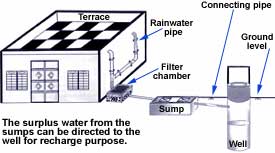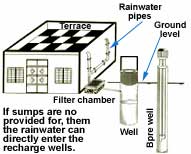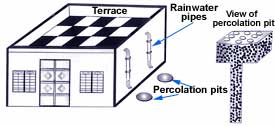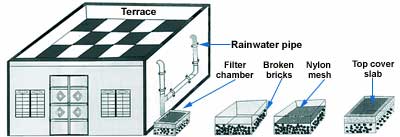| |
|
PERSPECTIVE |
|
| National water policy A futile
exercise |
|
IN FOCUS |
|
| Water riots breakout in Gujarat Bustards under threat Disappearing lakes and ponds |
|
INITIATIVE |
|
| Delhi prepares to catch rain Watering schools Ready to take action Gokak goes green Journalist's meet |
|
TECHNOLOGY |
|
| Easy steps to catch rain |
|
CSE'S LATEST DESIGNS |
|
| Sankat Mochan Mandir A role model in the making |
|
CHENNAI PAGE |
|
| Water suficient Municipal water bonds Active campaigner |
|
PROFILE |
|
| Water crusader |
|
TRADITION |
|
| Kata system |
|
NEWS FROM ABROAD |
|
| A water conscious city Ghana's privatisation woes |
|
OBITUARY |
|
| Vilasrao Salunke |
|
BOOK / DOCUMENTS |
|
| Glimpses of book |
|
EVENTS |
|
| Conference call |
|

| Vol. 4 | No. 2 |
April 2002 |
![]()
Easy steps to catch rain
The government of Tamil Nadu is flooding its population with information on rainwater harvesting to turn it into a mass movement. As a part of their awareness generation program, Chennai Metropolitan Water Supply and Sewerage Board has brought an easy to read manual on rainwater harvesting in Tamil and English languages. It clearly illustrates the step by step approach to implement rainwater harvesting in different dwelling units, ranging from houses with sloping roofs to cemented roofs. The manual was first distributed among state assembly members, on request.
The manual can be easily accessed at Metrowater’s official website – www.chennaimetrowater.com
| In houses with sloping roofs, the rainwater can be collected through PVC pipes. They are cut into half and are fitted along the sloping sides to divert the rainwater to sump or recharge well. |
 |
|
|
| The rainwater drainpipes should extend to the bottom of the building. To collect rainwater in a sump, a filter chamber of size 2.5’ x 2.5’ x 2.5’ is needed. This chamber has a layer of broken bricks at the bottom, followed by one feet of coarse sand. A nylon mesh is placed between these two layers. RCC slab is used to cover the filter. | |
 |
 |
 |
If there are no sumps and borewells, the rainwater may be directly recharged through percolation pits. The formation of these pits should be sandy, at the bottom. |
